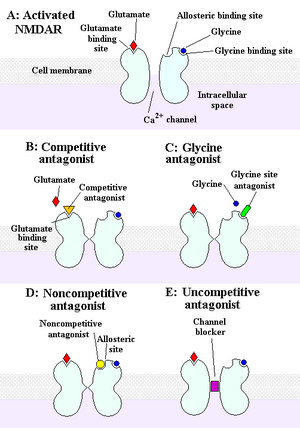The NMDA receptor is an ionotropic receptor that allows for the transfer of electrical signals between neurons in the brain and in the spinal column. For electrical signals to pass, the NMDA receptor must be open. To remain open, glutamate and glycine must bind to the NMDA receptor. An NMDA receptor that has glycine and glutamate bound to it and has an open ion channel is called "activated."
Chemicals that deactivate the NMDA receptor are called antagonists. NMDAR antagonists fall into four categories: Competitive antagonists, which bind to and block the binding site of the neurotransmitter glutamate; glycine antagonists, which bind to and block the glycine site; noncompetitive antagonists, which inhibit NMDARs by binding to allosteric sites; and uncompetitive antagonists, which block the ion channel by binding to a site within it
Chemicals that deactivate the NMDA receptor are called antagonists. NMDAR antagonists fall into four categories: Competitive antagonists, which bind to and block the binding site of the neurotransmitter glutamate; glycine antagonists, which bind to and block the glycine site; noncompetitive antagonists, which inhibit NMDARs by binding to allosteric sites; and uncompetitive antagonists, which block the ion channel by binding to a site within it
Examples
Competitive antagonists
- AP5 (APV, R-2-amino-5-phosphonopentanoate)
- AP7 (2-amino-7-phosphonoheptanoic acid)
- CPPene (3-[(R)-2-carboxypiperazin-4-yl]-prop-2-enyl-1-phosphonic acid)
- Selfotel: an anxiolytic, anticonvulsant but with possible neurotoxic effects.
Uncompetitive channel blockers
- Amantadine: used for treating Parkinson's disease and influenza and Alzheimer's.
- Dextrallorphan: a more potent analogue of dextromethorphan.
- Dextromethorphan: a common antitussive found in cough medicines.
- Dextrorphan: active metabolite of dextromethorphan.
- Dizocilpine (MK-801): an experimental drug used in scientific research.
- Ethanol: also known as alcohol, a widely used legal intoxicant.
- Eticyclidine: a Schedule I controlled substance in the United States.
- Gacyclidine: an experimental drug developed for neuroprotection.
- Ibogaine: a Schedule I controlled substance in the United States
- Magnesium
- Memantine: treatment for Alzheimer's disease.
- Methoxetamine: a novel designer drug sold on the internet.[citation needed]
- Nitrous oxide: used for anesthesia, particularly in dentistry.
- Phencyclidine: a Schedule II controlled substance in the United States.
- Rolicyclidine: a Schedule I controlled substance in the United States.
- Tenocyclidine: a Schedule I controlled substance in the United States.
- Methoxydine: 4-meo-pcp
- Tiletamine: an animal anesthetic.
- Xenon: an anesthetic.
- Neramexane: a memantine analogue with nootropic, antidepressant properties. Also a nicotinic acetylcholine antagonist.
- Eliprodil: an anticonvulsant with neuroprotective drug.
- Etoxadrol: a potent dissociative similar to PCP.
- Dexoxadrol: similar to etoxadrol.
- WMS-2539: potent fluorinated derivative of dexoxadrol.
- NEFA: a moderate affinity antagonist.
- Remacemide: a low affinity antagonist also a sodium-channel blocker.
- Delucemine: also a SSRI with neuroprotective properties.
- 8A-PDHQ: a high affinity PCP structural analogue.










0 comments:
Post a Comment